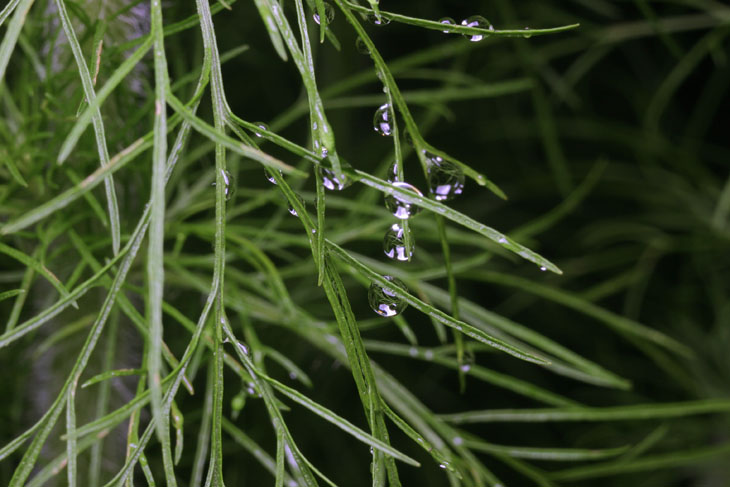
The dog fennel plants that provided so many photo subjects last year, visible in the wide image for my last ‘Frustrations’ post, are now taller than I am, and routinely examined for interesting subjects. This evening I noticed some suspicious dewdrops, suspicious because they were not uniform throughout the plants, and because they had more volume than dew normally does. Since I’d spent no small part of the day trying to capture a particular behavior, I started looking carefully, and soon confirmed my guess.
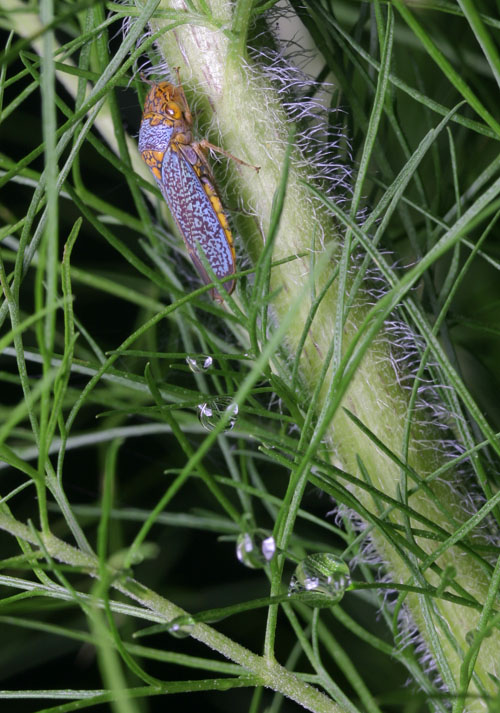 The culprit is a type of leafhopper known as a sharpshooter, in this case a broad-headed sharpshooter (Oncometopia orbona.) Colorful and rather large for a leafhopper at over 10mm for an adult, they get their ‘sharpshooter’ appellation from their habit, which has been a source of frustration to me for a few years now. Like most of the Cicadoidea superfamily to which they belong, they feed on plant saps obtained through a needlelike proboscis, and process it in large volumes. That which is not needed is expelled from t’other end with the exuberance of a suddenly-diaper-free infant, leaving copious amounts of sticky/oily residue everywhere that the arc reaches. I have to admit to some jealousy, since with an extra glass of iced tea I can spell my entire name, but I’ve never been called a sharpshooter. Broad-headed or otherwise…
The culprit is a type of leafhopper known as a sharpshooter, in this case a broad-headed sharpshooter (Oncometopia orbona.) Colorful and rather large for a leafhopper at over 10mm for an adult, they get their ‘sharpshooter’ appellation from their habit, which has been a source of frustration to me for a few years now. Like most of the Cicadoidea superfamily to which they belong, they feed on plant saps obtained through a needlelike proboscis, and process it in large volumes. That which is not needed is expelled from t’other end with the exuberance of a suddenly-diaper-free infant, leaving copious amounts of sticky/oily residue everywhere that the arc reaches. I have to admit to some jealousy, since with an extra glass of iced tea I can spell my entire name, but I’ve never been called a sharpshooter. Broad-headed or otherwise…
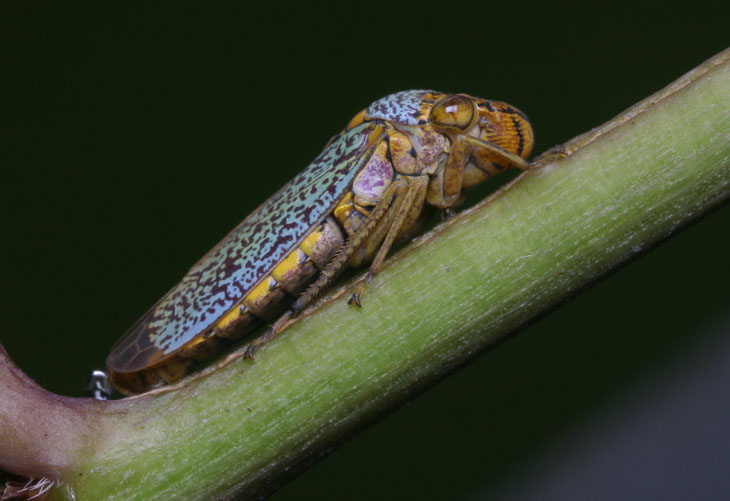
Here’s a better look, which not only gives the barest peek at the proboscis (which appears to be projecting from the chin area between the elbows,) but the habit that’s been the source of frustration to me, compounded again today – well, yesterday now, as I type this past midnight and feel some stupid reason to honor the date technicality. Visible at the hind end of my subject is a bright spot, a globule of exudate immediately prior to its launch into the air. One might get the impression that this droplet would be recognizable for a fraction of a second before release, and one would be very wrong – the action is fast enough that, in the right light conditions, the only thing seen is a momentary reflection, so brief that the sharpshooter appears to have a flashing taillight like an aircraft. Seriously, the effect is very distinctive, even when you know what you’re looking at – so much so that I just went out a few minutes ago to do a lighting test to see if the composition of the sharpshooter wee made it more reflective/refractive that normal water. Results: not that can be seen in my photos. There goes my honorary doctorate…
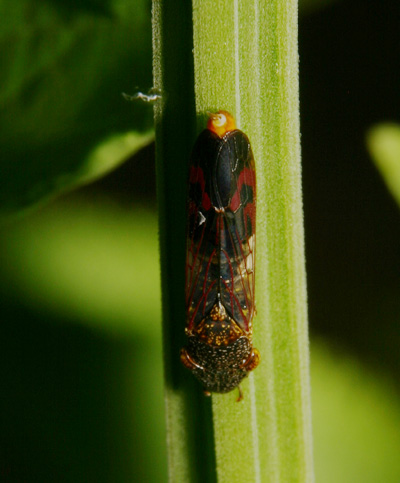 A few years back I’d seen the same thing, only this time with a glassy-winged sharpshooter (one gets the impression that whoever was naming these was tired and not trying for originality anymore, but anyway, the scientific name is Homalodisca vitripennis.) Even in open shade without direct sunlight, the flash is plainly visible, and I spent a lot of time in the botanical garden where I’d spotted it, trying to get an image of the effect. Let’s put it this way: the effect lasts less that 1/15th of a second, probably closer to 1/100th if I’m any judge. Shutter speed is 1/200th, strobe duration less than 1/1,000th. Human response time is way too slow to trigger the shutter upon seeing the effect, so it’s all up to timing (of a semi-sporadic behavior) and dumb luck. That’s all I’m going to credit for this image, which actually caught a droplet in midair, albeit with a bit of distortion. For a while I didn’t even realize that I had, since I was skimming through a stack of images looking for the flash itself.
A few years back I’d seen the same thing, only this time with a glassy-winged sharpshooter (one gets the impression that whoever was naming these was tired and not trying for originality anymore, but anyway, the scientific name is Homalodisca vitripennis.) Even in open shade without direct sunlight, the flash is plainly visible, and I spent a lot of time in the botanical garden where I’d spotted it, trying to get an image of the effect. Let’s put it this way: the effect lasts less that 1/15th of a second, probably closer to 1/100th if I’m any judge. Shutter speed is 1/200th, strobe duration less than 1/1,000th. Human response time is way too slow to trigger the shutter upon seeing the effect, so it’s all up to timing (of a semi-sporadic behavior) and dumb luck. That’s all I’m going to credit for this image, which actually caught a droplet in midair, albeit with a bit of distortion. For a while I didn’t even realize that I had, since I was skimming through a stack of images looking for the flash itself.
Today/yesterday/Monday/whatever, I figured I was on top of it enough that, when I found a collection of sharpshooters on the vine climbing the front porch, I could set up shop and capture the effect in detail. With the right angle I could actually see the wee arc, so capturing this in an image should have been within the realm of possibility (that’s called, “foreshadowing.”) Yet none of the techniques I tried worked out even remotely decently, save for one. I tried just timing, like above, to capture it by luck, and the multiple-burst strobing effect of the Metz flash, 10 blinks per second for two seconds, and using a black background, and even reducing the ambient light for a long exposure with a neutral-density filter (basically a tinted lens to prevent overexposure with slow shutter speeds.) In one frame I did actually catch a sequence of droplets, but they virtually disappear against the minimal reflected light from the backdrop I used – I really need to find a surface with as low reflectivity as possible. Maybe a piece of scrapped stealth aircraft…
The only thing that produced something noticeable, without getting up to an image to be proud of, was a 1/6 second ambient light exposure, with an LED flashlight to provide a little additional reflective quality…
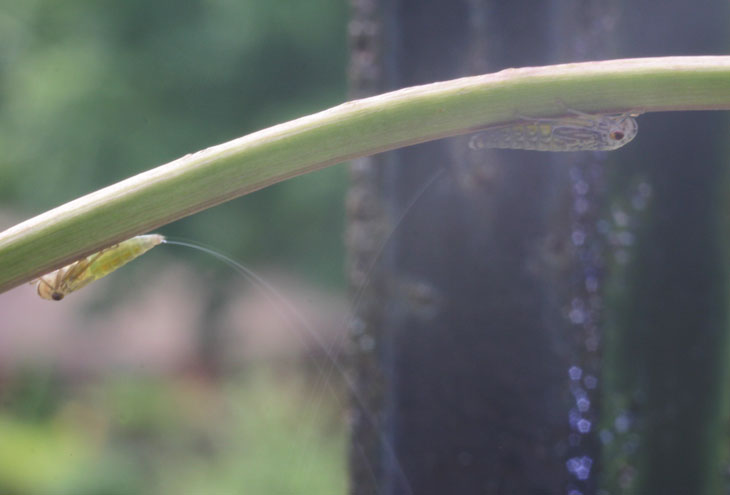
… and for that, I had to boost contrast a bit because a long exposure of shadowed subjects doesn’t get any better with time. You’ll notice that, even in a mere 1/6 second, both insects produced multiple drops that traveled completely out of the frame, demonstrating the momentary nature of the effect. I finally decided I’d try to capture this at night, when no ambient light had to be compensated for and I could use only strobes; the light wouldn’t reach to the lawn in the background and the droplets should have shown very well against the darkness. This does, of course, require that the sharpshooters are actually feeding at night, so you can figure out how this failed.
I have no useful way of doing video, and believe me, this has entered my thoughts before. What’s stopped me, besides the expense, has been that much of the work I do here is with strong flash assistance, very often freehand because setting up a tripod is out of the question (I’ll go into this in greater detail in another post.) And the focus range is very, very narrow. So not only would I need a set of powerful constant-output lights, I’d need to run power cords since no batteries can handle that kind of wattage for very long. And then, what would likely result is nausea-inducing clips wandering in and out of focus as I attempted to hold tight on the subject while leaning awkwardly over the plant it’s sitting on. I reckon I have enough frustrations as it is.



















































